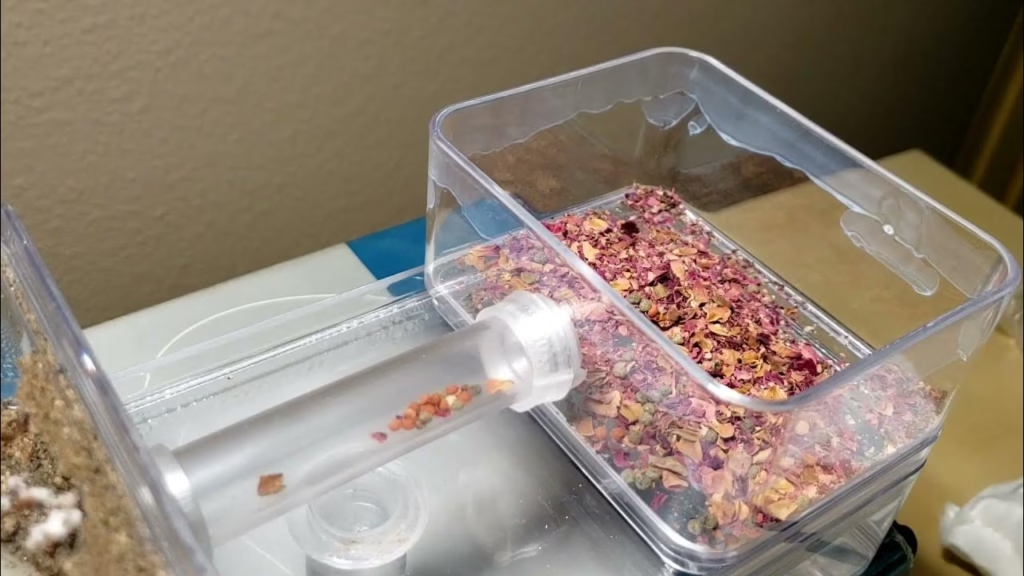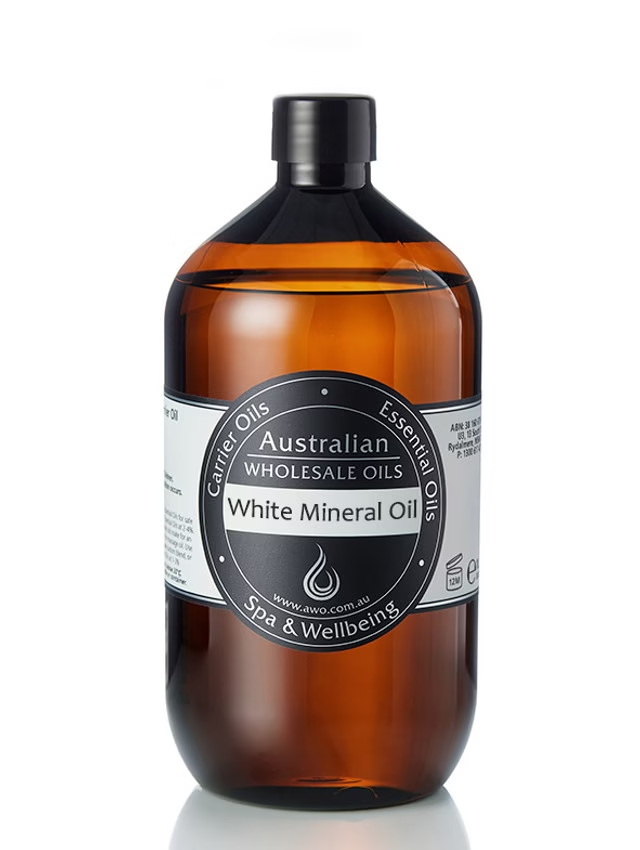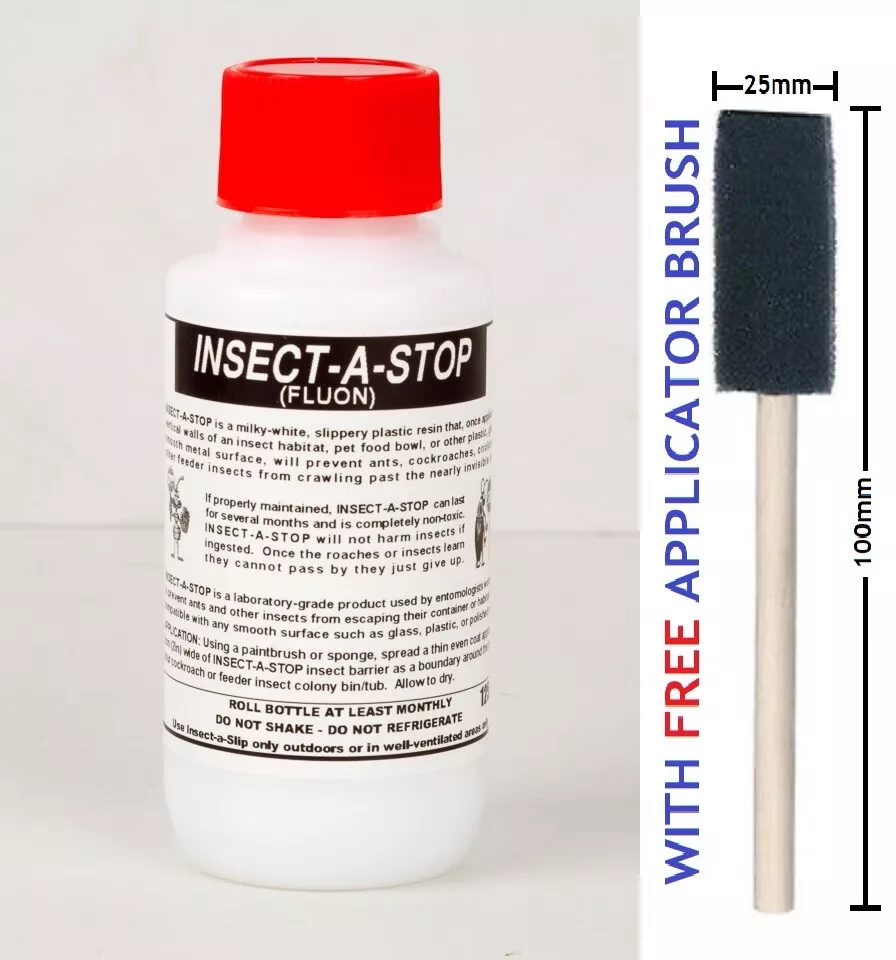Ants are curious, persistent, and excellent climbers. A great nest means nothing if your containment fails. This guide compares the most effective ant barrier options—PTFE/Fluon, talc mixes, mineral oils, and hardware solutions—so you can build an escape-proof setup that’s safe for your colony.
Quick Comparison – Ant Barrier Options
| Barrier Type | Best For | How It Works | Pros | Cons | Reapply |
|---|---|---|---|---|---|
| PTFE / Fluon (liquid) | Most species; smooth rims & vertical walls | Ultra low-friction film ants can’t grip | Very effective; dries clear/white; long-lasting | Needs correct technique; degraded by dust/humidity | 2–8 weeks |
| Talc + Alcohol/Water | Budget setups; temporary use | Powder makes surface crumbly & slippery | Cheap; easy to source | Messy; short lifespan; poor in humidity | 3–7 days |
| Mineral Oil / Baby Oil Rim | Short-term in outworlds | Slick film prevents climbing | Simple; no mixing | Collects dust; can drip; not for verticals | 3–10 days |
| Hardware (tight lids, mesh, gaskets) | All setups; micro species | Physical exclusion & airflow control | Works even if chemical barriers fail | Needs precision; adds cost | On wear/inspection |
📖 External resource: background on formicaria design.

1. PTFE / Fluon – The Gold Standard
Best for: most species, especially persistent climbers and jumpers. A properly applied PTFE band on a smooth vertical surface is very hard for ants to cross.
How to apply correctly
- Clean the rim with isopropyl alcohol; dry completely.
- Use a foam brush to paint a 2–3 cm band—thin and even.
- Let dry fully (15–30 minutes). Don’t touch the band afterwards.
- Keep dust off the band; dust kills slipperiness.
Troubleshooting
- Ants crossing? Reclean and reapply a fresh thin coat. Remove old residue if it’s turning chalky.
- Humid room? Use a wider band and reduce condensation near the rim.
- Textured plastic? PTFE works best on smooth acrylic or glass.
🔗 Related: Best Ant Nest Types – Pros & Cons
2. Talc Barriers – Cheap & Cheerful (Short Term)
Best for: budget or temporary setups. Mix plain talc (unscented) with isopropyl alcohol to a paintable slurry, apply a thin strip, and let it dry to a powdery band.
- Pros: Very cheap; easy to refresh; good for quick projects.
- Cons: Messy; short lifespan; fails fast in high humidity; some species power through.
- Tip: Brush off and reapply every few days; keep food splashes away from the band.
🔗 Related: The Ultimate Ant Feeding Guide
3. Mineral Oil Rims – Simple & Slippery
Best for: outworld rims on horizontal surfaces only (oil can drip). Wipe a very thin film of mineral/baby oil around the top inner lip.
- Pros: Quick; no mixing; available everywhere.
- Cons: Attracts dust; can wick or drip; needs frequent wiping; useless on vertical surfaces.
- Tip: Apply sparingly; wipe and refresh weekly or sooner if dusty.

4. Hardware Matters – Lids, Mesh & Gaskets
Even the best chemical barrier can fail if your lid is loose. Combine barriers with good engineering:
- Tight-fitting lids: test by gently pressing corners; add clips if needed.
- Fine stainless mesh: 200–400 micron for ventilation holes; hot glue or gasket tape for airtightness.
- Gasket tape: foam/silicone tape around lids or module joints to seal micro-gaps.
- Cable pass-throughs: route heat probe/LED cables through grommets; seal with silicone.
🔗 Planning a bigger setup? See: Formicarium Upgrade Guide – When & How
5. Species Notes – Climbers vs. Non-Climbers
Barrier choice can depend on species:
- Excellent climbers/jumpers: Myrmecia (Jumping Jacks), Ochetellus (Black Household Ant) — favour PTFE + tight lids.
- Moderate climbers: Polyrhachis (Golden Spiny) — PTFE works well; watch condensation.
- Poor climbers: some Rhytidoponera — still use a barrier; they will surprise you near joins.
🔗 Species examples: Jumping Jack Ant Care | Black Household Ant Care | Golden Spiny Ant Care
6. Maintenance & Hygiene
- Keep the band clean: food splashes and dust kill barrier performance.
- Reapply before failure: set a reminder to refresh PTFE every few weeks.
- Control condensation: avoid humidifiers directing mist at the rim; add a cover that doesn’t touch the band.
- Outworld discipline: feed on dishes; remove leftovers daily to avoid grime on the barrier.
🔗 New to nest choices? Start here: Best Ant Nest Types
7. Common Barrier Myths (Busted)
- “PTFE lasts forever.” No—dust and oils from food/ants reduce performance. Refresh on a schedule.
- “Talc works in any humidity.” It cakes and fails in damp conditions. Use PTFE in humid rooms.
- “Oil is fine on vertical walls.” It wicks and drips—save it for horizontal rims only.
- “Hardware is optional.” A great lid makes every chemical barrier better.
Final Thoughts – Build Redundancy for Real Escape-Proofing
The most reliable escape-proofing combines a good chemical barrier (PTFE for most setups) with tight hardware (mesh, gaskets, lids). Keep the barrier clean, refresh it before it fails, and match your approach to the species. Do that, and you’ll turn runaways into non-events.

